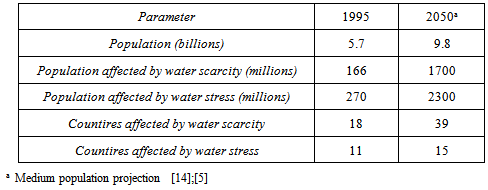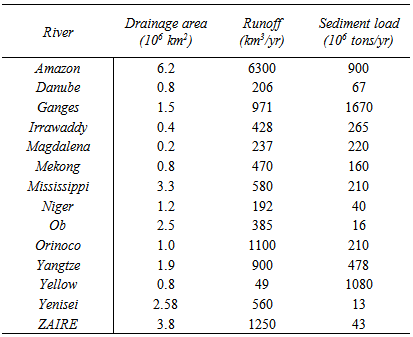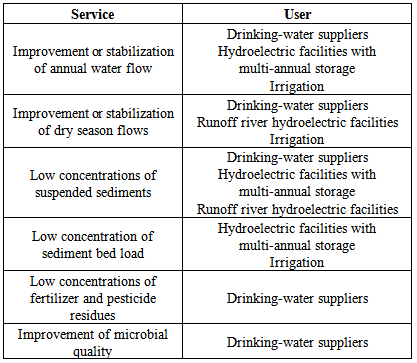-
Paper Information
- Previous Paper
- Paper Submission
-
Journal Information
- About This Journal
- Editorial Board
- Current Issue
- Archive
- Author Guidelines
- Contact Us
Resources and Environment
p-ISSN: 2163-2618 e-ISSN: 2163-2634
2014; 4(2): 104-114
doi:10.5923/j.re.20140402.04
Watersheds and Rehabilitations Measures - A Review
Leslie Mawuli Aglanu
Department of Environmental Governance, University of Freiburg, Germany
Correspondence to: Leslie Mawuli Aglanu , Department of Environmental Governance, University of Freiburg, Germany.
| Email: |  |
Copyright © 2014 Scientific & Academic Publishing. All Rights Reserved.
Freshwater scarcity remains a problem for millions of people around the world, especially in arid and semiarid regions. Watersheds provide human societies with many goods and services such as clean water, conservation of biodiversity, erosion control and carbon sequestration. Unlike other resources such as minerals and timber, the value of these goods and services is seldom expressed in monetary terms. Many countries have laws regulating access to and use of watershed resources however, these are often inefficient and difficult to implement. This paper hence reconnoitres sustainable watershed management and urges relevant institutions such as Environmental Protection Agencies, Water Research Institutes and Governmental Agencies of the need for a participatory integrated approach which includes the various physical, vegetative and human components within watersheds. It is concluded therefore that the fundamental social problem of watershed management is that it often distributes benefits and costs unevenly, making it a likely source of conflict between residents upstream and downstream. Watershed management practices should thus, be implemented in a manner that solves soil and water degradation problems but at the same time be socially and politically acceptable and economically feasible. The challenge here is to internalize the costs and benefits in such a way that all the stakeholders are part of a win-win scenario.
Keywords: Watershed, Degradation, Resources, Scarcity, Stress
Cite this paper: Leslie Mawuli Aglanu , Watersheds and Rehabilitations Measures - A Review, Resources and Environment, Vol. 4 No. 2, 2014, pp. 104-114. doi: 10.5923/j.re.20140402.04.
Article Outline
1. Introduction
- Watershed degradation marks the deterioration in hydrological behaviour of river systems which reduces the health and potential of land and water by causing a water flow of inferior quality, quantity and timing. This process, predominantly human induced, have been a major source of conflict among various land and water users.Degradation of a watershed can have various forms: depletion of water resources, soil erosion and land degradation, impoverishment of the vegetative cover, and damage to infrastructure. Surface runoff is one of the causes for the depletion of water resources on the one hand and soil erosion on the other hand. Another big problem is the pollution of water with various hazardous pollutant such as agrochemicals and microorganisms which poses health risks to the people who depend on that specific watershed for their sustenance [1]. Thus, prevention of pollution and hence, the protection of water quality, is crucial within a watershed. Many forms of watershed degradation are evident as some form of direct damage to the soil and/or the ecosystem. In the case of soil erosion and deposition, the effects of degradation are manifested in the loss or transfer of soil, which has direct consequences in reducing the productivity of the site. With regards to soil degradation, the effects are manifested in a deterioration in the in situ properties of the soil again with direct consequences in term of reduced productivity. In the case of ecosystem alteration on the other hand, which includes changes to the vegetative cover and composition and the introduction of plant and animal pests, the immediate consequence is a deterioration in the quality of the entire ecosystem, which the land unit under threat supports [2].Nevertheless, forest shield the soil surface from heavy rainfall. It helps reduce the rate of run-off by increasing the rate of infiltration and as a consequence, decrease the amount of flooding, mitigate soil erosion and limit the sedimentation of rivers, thus protecting the watershed. On the other hand, deforestation of watersheds especially around smaller rivers and streams can increase the severity of flooding, reduce stream flows by lowering the water table and increase sedimentation of rivers [2]. Accelerated erosion, soil salinization, impairment of water quality, landslides, siltation of rivers and dams and increased flooding downstream are other common adverse consequences of deforestation. Watershed degradation in many developing countries threatens the livelihood of millions of people and constrains the ability of countries to develop a healthy agricultural and natural resource base. Increasing populations of people and livestock, particularly in the steep, mountainous watersheds of Nepal and the Himalaya region for instance, are rapidly depleting the existing natural resource base because the soil and vegetation systems cannot support present levels of use [3].
2. Watershed the Basic Hydrologic Unit
- Watersheds are hydrologically connected geographic areas that contain interconnected environmental processes [4]. Rainwater, runoff, snowmelt and groundwater are all elements of this hydrologic entity. Other factors such as climate, land features, vegetation, and land use all affect the quality and quantity of water within the watershed. Hydrologic processes (evapotranspiration, flow, runoff, infiltration, seepage) within a watershed are interlinked and appropriately assessed within its confine [5]. Being that basic hydrologic unit, water from outside cannot enter the watershed and that from within leaves it from a well-defined point. Wetlands are a major component of a watershed which directly affects water quality, acting as sediment basins, filters and sinks for nutrients that would otherwise cause river and lake eutrophication and trigger algal blooms. Because of their ability to absorb nutrients from water and promote nutrient cycling through plant take-up, wetlands can become highly productive ecosystems, characterized by seasonal changes in plant mix and grazing patterns for a variety of wildlife and domestic animals [6]. Wetlands may have significant effects on the hydrology of a watershed and its river system. They can be effective flood detention storages, reducing flood peaks downstream and attenuating the flood wave pattern. They alsoact as ground water recharge areas, which is a major source of freshwater, contributing about half of the total water consumed by humans for drinking, agriculture, and other purposes [7]. In addition, depending on the water table depth, groundwater may serve as a significant source of water to lakes, rivers and wetlands [8]. Groundwater protection, which includes consideration of both quantity and quality, is therefore crucial [9]. Watersheds are hence effective natural units that are used to analyse the essential physical, chemical and biological ecosystem characteristics and the effects of human influence on these factors in an area [10]. Its management hence includes the analysis, protection, repair, utilization and maintenance for optimum control and conservation of water in relation to other resources.
3. Research Method
- This paper reviews ample secondary materials on watersheds, its usage and management across the world: specifically published books, journal articles, annual and technical reports of some relevant institutions as well as public and government documents. Content analysis of the connexion water use, watershed resources and management, and human appropriations has been carried out. Based on relevant literature, analysis and discussions have clearly provided the contextual justificationon the unsustainable means of human exploitation of the various watershed resources.The underpinning theoretical framework of the research is the Driving force, Pressure, State, Impact and Response (DPSIR)framework which is seen as giving a structure within which to present the indicators needed to enable feedback to policy makers on environmental quality and the resulting impact of the political choices made or to be made in the future. According to Figure 1, there is a chain of causal links starting with ‘driving forces’ (economic sectors, human activities) through ‘pressures’ (emissions, waste) to ‘states’ (physical, chemical and biological) and ‘impacts’ on human health, ecosystems and functions, eventually leading to political ‘responses’ (prioritisation, target setting, indicators) [11]. The DPSIR framework is useful to describe causal relationships of environmental problems. In order to better understand their dynamics, it focuses on the links between the DPSIR elements.
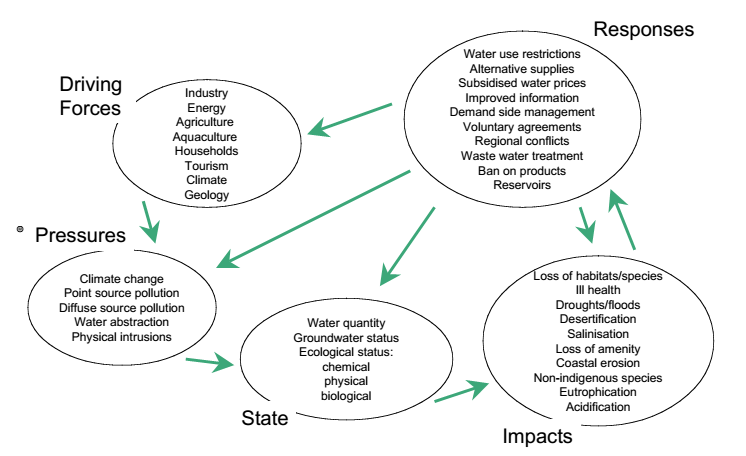 | Figure 1. A Generic DPSIR Framework for Water [11] |
- The aim of managing water resources is to safeguard human health whilst maintaining sustainable aquatic and associated terrestrial ecosystems. The DPSIR framework was hence adapted based on the European Environment Agency's work on water. The Framework allows a comprehensive assessment of the issues through the examination of relevant Driving forces and Pressures on the environment, the consequent State of the environment and its Impacts, the Responses undertaken and the interlinkages between each of these elements through the quantification and identification of the current state of and impacts on the environment and how these are changing with time. The state of water is determined by natural factors such as geology, climate and by the pressures exerted by human activities.
4. Current Water Conditions
4.1. State of the World’s Water Reserve
- As a culture, we have lost our collective memory of water as being the archetypal source of our dreams replacing it with water regarded as only stuff [12]. The core of the problem is that for most of us water flows by unappreciated and occasionally even unrecognized. The disheartening truth is that as a civilization we have become effectively blind to both the inherent beauty [13] and experiential delight [14] of water, failing to see the imminent danger that awaits us as in Table 1 and Table 3 with regards to water scarcity and stress.
|
|
4.2. State of the World’s Watersheds
- Most of the world’s watersheds are facing seriouse thrests as indicated in Table 3. From evidences arround the world, Lake Cocibolca is a major freshwater resource in Central America and the second largest lake in Latin America after Lake Titicaca. With a population of about 750,000, the watershed is a major area for agricultural production and the lake is beginning to be used as a source of water supply for some coastal towns; its role as a source of drinking water may grow in the future [12]. However, the watershed has lost most of its forest cover over the last century as cattle farming has expanded, exposing the watershed’s fragile volcanic soils and steep slopes to erosion which is deposited into the confluence of the San Juan River and the lake. Other environmental problems stem from the use of agrochemicals, tilapia farming, and the flows of untreated or poorly treated wastewater from coastal towns. The result has been a reduction in water quality: nutrient levels are rising and there is evidence of agrochemical and bacteriological contamination. However, the extent of these problems is uncertain.
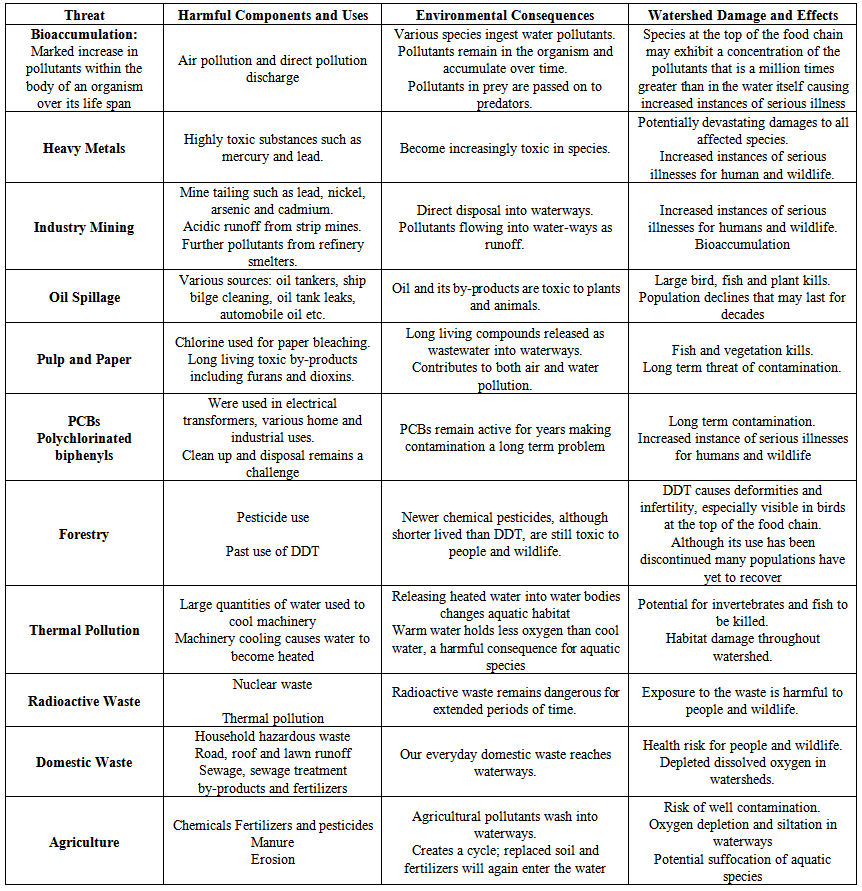 | Table 3. Watershed Threats [1] |
4.3. Watershed Human Ecology
- Most people live in watershed or river basin ecosystems that they have moulded to meet their needs throughout history. With the exception of a few residual and strictly protected areas, the ecology of most watersheds in many ways are human-made [25]. The relationship between human populations and watersheds has usually been adaptive, homeostatic and resilient. Factors in watershed human ecology fall under four main headings, Figure 2: local population dynamics, local livelihood systems, external interests, and policies, norms and laws. Interactions among these factors largely determine a watershed’s environmental conditions at a given time.
 | Figure 2. The human ecology of watersheds [25] |
4.4. Watershed Economics
- Watersheds provide human societies with many goods and services, such as clean water, erosion control, carbon sequestration and conservation of biodiversity [29]. Unlike other resources such as timber, livestock products or minerals, the value of these watershed goods and services are rarely expressed in monetary terms [25]. Watershed-generated environmental public goods and services as shown in Table 4 include regulation of water flow and quality, sediment delivery and the maintenance of landscape beauty. However, the value of a forest in controlling stream-bank erosion and sediment load in a river is not reflected in the market price of the forest land, neither is the value of a highland swamp in recharging an aquifer reflected in water prices. Society generally attaches a high value to the positive externalities of watershed landscapes and will take action to guarantee that they are provided for and conserved. This is the primary justification for the public funding of watershed management programmes. Many countries have laws regulating access to and use of watersheds, but most of them are often inefficient and difficult to implement [25].Command and control approaches of protecting the flow of benefits from watershed landscapes have often failed. Efforts have hence been recently made to create markets for these externalities. Table 4 summarizes the watershed related environmental services identified in some Latin American studies.
|
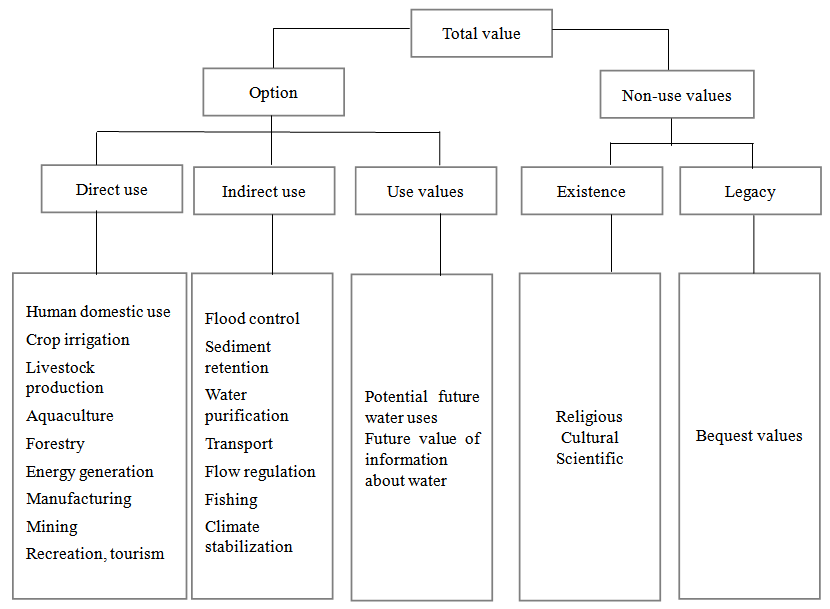 | Figure 3. Total economic value framework as applied to watershed water resource [34] |
- According to [18], giving an economic value to such services could in theory make it possible to establish markets between those who benefit from them (the “buyers”, for example water companies or downstream landowners) and those who contribute to maintaining them (the “sellers” or service providers, such as watershed residents and forest management agencies). These market incentives and rewards and any other associated contractual arrangements between buyers and sellers would in turn encourage protection of watersheds by giving an economic value to the services they provide [35];[36].
5. Results and Discussion
5.1. Watershed Rehabilitation and Water Sector Reforms
- Concern for the declining health of watersheds have led to the implementation of various management practices to restore the proper hydrologic functioning of degraded watershed lands [37]. Management practices to rehabilitate watersheds in poor condition include: controlling gullies and mass wasting with properly constructed check dams and other mechanical controls; protecting unstable stream channel from further damage; establishing protective tree, shrub, or herbaceous covers on degraded sites and further curtailment of timber harvesting, livestock grazing, and other exploitative land-use practices. Presently, restoring riparian ecosystems to retain their hydrologic equilibrium is a major focus of watershed management [38]; [39].Over the last two decades, new strategies and supporting institutions for natural resource management have emerged throughout sub-Saharan Africa. There is a shift from centralized and State-driven natural resource management to decentralized and community-based regimes. As part of this, water sector reforms in several countries addresses the environment as a legitimate water user and emphasize pollution control [25]. Water management functions are increasingly being decentralized to the watershed level to enable stakeholders have more say in the management of water in their own areas. For instance, in 1998, Zimbabwe passed a new water act based on economic efficiency, environmental sustainability and equitable use. The act treats groundwater and surface water as parts of one hydrological system. Water cannot be privately owned, and water rights have been replaced with short-term water use permits; renewal is subject to water availability and evidence of efficient use. Watershed and sub-watershed catchment councils of stakeholders have also been formed [40]. In 1996, the Parliament of Ghana established the Water Resources Commission (WRC) to regulate and manage the country’s water resources and coordinate related government policies. The WRC comprises the major regulators and users in the water sector, providing a forum for integrating and balancing the different interests of water institutions and civil society stakeholders. Since 2001, a water management fund has financed conservation activities, information systems, local watershed management institutions and research [41]. The income of this fund comes from a raw water charge (a 0.7 percent tariff increase), licence fees and fines for offences. Since 1994, government policies in South Africa have focused on equitable and sustainable social and economic development for the benefit of all. In 1997, the Cabinet adopted a National Water Policy with three main objectives: equitable access to water, sustainable use of water and efficient and effective water use. The National Water Act is based on these objectives and provides for the protection, use, development, conservation, management and control of South Africa’s water resources [42]. A vital element of this strategy is the progressive decentralization of water resource management to catchment management agencies and local level water user associations which distribute the available water among competing user groups. In Central America, the Lake Cocibolca watershed which is part of the corridor that passes from Lake Managua south to the San Juan River has been recognized as the best opportunity for ecotourism development [12]. The provision of direct economic incentives through the payment for ecosystem services programs and investments as well as supporting the growth of environmentally sustainable off-farm activities have helped reduced the pressure on the watershed. The Ministry of Tourism in Nicaragua has acknowledged ecotourism projects in the Lake Cocibolca watershed, including Ometepe Island, the Solentiname Islands and the San Juan River as one of the best opportunities to develop ecotourism and protect the watershed [12]. In the US however, storm water best management practices (BMPs) such as wetlands, rain gardens or grass swales installed within the stream corridor or upland areas have helped capture and treat storm water runoff before it reaches the streams. Stream bank root systems provided by riparian buffers have also prevent further stream channel erosion and sedimentation [6]. Furthermore, buffering zones provide the service of filtering debris and toxic chemicals from surface flow before it reaches catchment waters. Hitherto, pervious surfaces such as unpaved ground which slows down the movement of storm water, allowing sediments, nutrients and other contaminants to infiltrate rather than flowing directly into the receiving water body are being recommended over impervious surfaces [9]. For instance, materials such as porous asphalt are available as an alternative to traditional impervious materials which have shown to effectively remove contaminants from storm water runoff. In a study examining runoff over porous versus impervious roads in Texas, scientists found that the porous asphalt removed approximately five times the amount of suspended solids [43]. Erosion can also be minimized by utilizing proper soil stabilization techniques. For example, [44] found that erosion control blankets successfully prevented soil erosion at construction sites.
5.2. The Thwarts of Watershed Rehabilitation Measures
- To ensure sustainable watershed management, there is the need for an integrated and a participatory approach that includes the various physical, vegetative and human components within the watershed [3]. In most cases however, some of these elements are neglected.The world is rapidly converting forest, wetlands and other critical habitats into agricultural lands and also diverting major rivers to produce food in other to meet the growing demands [45]. How to produce more and better food and maintain or improve critical ecosystem services without further undermining our environment has been a major challenge.This calls for the assessment of watershed development and management approaches with a view to addressing biophysical, socio-economic, institutional and policy issues. Several reviews on the performance of watershed development projects [46]; [47]; [48]; [49]; [50]; [51]; [52] have diagnosed various limitations of watershed programmes, including the following:Ø Landless and marginal farmers often benefit only marginally or not at all thereby increasing inequities at the village level.Ø Domestic, livestock and ecosystem water needs often do not get adequately addressed in management measures.Ø Downstream impacts of intensive upstream water conservation are not amply being considered.Ø Costs at which the gains are achieved are considered to be high.Ø Inhabitant’s participation is often limited to the watershed project implementation stage.Ø No/little building of institutions for long-term collective management of resources.These problems arise because the interaction between the biophysical and the socioeconomic processes in watershed development is not properly addressed in an integrated manner. Results from a meta-analysis comprising 310 watersheds revealed that the mean benefit-cost ratio of watershed programmes was quite modest at 2.14 [47]. In India for instance, watershed development projects with insufficient understanding of land and water interactions have resulted in reduced access to common property water for poorer people, unsustainable rates of groundwater depletion, closure of catchments and serious downstream and environmental impacts [53]. The fundamental social problem of watershed development is that it often distributes benefits and costs unevenly, making it a likely source of conflict between residents upstream and downstream [3]. The challenge is to internalize the costs and benefits in such a way that all the stakeholders are part of a win-win scenario.
5.3. Strategies to Improve Watershed Rehabilitation Measures
- Water is a resource that is most likely to cause trouble. Unless humans understood the value of water, they will never do anything sensible in terms of conservation [20]. Hence, urgent actions needs to be taken by policy and decision makers at the highest levels of government to expose the imminent danger of watershed degradation to the general public and set up participatory measures with the aim of halting and reversing the degradation processes. To accomplish this, a balance between population and the environmental carrying capacity of upland watersheds must be achieved. In steep mountainous watersheds undergoing severe degradation, urgent policies and programme responses are needed within the next decade. Management practices implemented should not only solve soil and water degradation problems but must at the same time be socially and politically acceptable and economically feasible. Solutions must not ignore the basic needs of people living in upland watersheds; incentives may be needed to change existing land-use practices into environmentally sound and sustainable resource use. The instability of land tenure and the complexity of user rights which have over the years seriously constrained the development of best land use practices needed to stabilize forest and rangelands needs to be passionately addressed. Watershed management programmes cannot become effective on a sustainable basis until such constraints are overcome.National programmes needs to unambiguously resolve inequities that result from implementing watershed management programmes. Resources should be reassigned from the politically and economically more powerful lowland communities who are often the major heirs of management measures to the increasingly penurious upland dwellers who must limi ttheir current livelihood activities. Good and working institutions are also needed in most countries to coordinate and effectively carry out the planning, implementation and monitoring of watershed management programmes. Notwithstanding, just as water and sediment flow in response to gravity, processes which do not necessarily coincide with political or institutional boundaries must also be recognized in management measures.
6. Conclusions
- Watershed management projects and programmes are being implemented throughout the world. It is considered by many to be one of the most important development sectors now and will continue to be so unless these difficulties are addressed. As the trend continues towards empowerment of rural people to manage their natural resources, the integrated multiple use concepts of watershed management at the community and farm levels with linkages to local and State governments will become more viable.The watershed management development approach is not perfect in any sense. It continues to evolve with time, with ever-changing development needs. Nevertheless, good watershed management will require the striking of a balance between economic objectives for productive land use and ecological objectives for the maintenance of ecosystem quality and diversity. This kind of approach requires the adoption of an ethic of ecologically sustainable development which in itself is the essence for the integrated watershed management approach.
References
| [1] | Watershed Wisdom; healthy lifestyles for Nova Scotians and their environment. Availableat:http://www.coastalaction.org/downloads/watershed_wisdom.pdf assessed 10th March, 2014. |
| [2] | JICA, 2007, The study on community-based integrated watershed management in Laclo and Comoro River Basins in the Democratic Republic of Timor-Leste. Toward “Sustainable Watershed Management”. Newsletter of JICA Study Team for CBIWM in Laclo and Comoro River Basins. Volume No. 1 Issue No. 2 September 2007. |
| [3] | Sharma, B. R., Samra, J.S., Scott C.A. and Wani, S. P., 2005, Watershed Management Challenges Improving Productivity, Resources and Livelihoods. International Water Management Institute in association with the Indian Council of Agricultural Research and the International Crops Research Institute for Semi-Arid Tropics. Malhotra Publishing House, New Delhi-110015 India. |
| [4] | Brant, A., Piggott, D., Petal, R. and Irshaidat, W., 2010, Integrated Watershed Management Plan: Candelaria Watershed, Campeche, Mexico. |
| [5] | Lal, R. Ed., 1999, Integrated watershed management in the global ecosystem. CRC Press LLC. |
| [6] | Starkweather Creek Watershed: Current Conditions and Improvement Strategies in an Urban Context 2006. Water Resources Management Practicum 2005. Nelson Institute for Environmental Studies, University of Wisconsin–Madison. |
| [7] | New Jersey Geological Survey, 2009, Aquifer Recharge Mapping. Availableat:http://www.state.nj.us/dep/njgs/enviroed/aqfrchrg.htm. Assessed on 17 march, 2014 |
| [8] | Brooks K.N., Ffolliott P.F., Gregersen H.M., and DeBano L.F. Hydrology and the Management of Watersheds.Iowa 2003: Iowa State Press, pp. 334-337. |
| [9] | Thomassey, G., Emmet county local ordinance gaps analysis 2013. Tip of the Mitt Watershed Council, Petoskey, MI 49770. |
| [10] | Ponce-Hernandez, R., 2010, Laboratory outlines 1-6 and lecture slides 1-12. ERSC-GEOG 4640H –Integrated Watershed Management. Trent University, Peterborough, Ontario. |
| [11] | Kristensen, P., 2004, The DPSIR framework. Paper presented at the 27-29 September 2004 workshop on a comprehensive / detailed assessment of the vulnerability of water resources to environmental change in Africa using river basin approach. UNEP Headquarters, Nairobi, Kenya. |
| [12] | World Bank, 2010, Republic of Nicaragua policy and investment priorities to reduce environmental degradation of the Lake Nicaragua watershed (Cocibolca): Addressing key environmental challenges – Study 2 June 29, 2010. Sustainable Development Department, Latin America and the Caribbean Region. Report No. 67497 – NI. |
| [13] | Dreiseitle, H., Grau, D. and Ludwig, K.H.C., 2001, Waterscape: planning, Building and Designing with Water. Birkhäuser, Switzerland (ISBN 3-7643-6508-0). |
| [14] | Gardner-outlaw, T. and Engelman, R., 1997, Sustaining Water: Easing Scarcity, a second update, Population Action International, Washington, D.C. |
| [15] | Millman, J.D. and Meade, R.H., 1983, Worldwide delivery of river sediment to the ocean, J. Geol. 91:1-21. |
| [16] | Van der Leeden, F., Troise, F.L. and Todd, D.K. Eds., 1994, The Water Encyclopedia, 2nd ed. Lewis Publishers, Chelsea, MI. |
| [17] | Pantin, D. and Krishnarayan, V., 2003, “Incentives for watershed management in Trinidad: results of a brief diagnostic”. Pages 40-52 in Tighe Geoghegan, Vijay Krishnarayan, Dennis Pantin and Steve Bass. Incentives for watershed management in the Caribbean: diagnostic studies in Grenada, Jamaica, St. Lucia and Trinidad. Laventille, Trinidad: Caribbean Natural Resources Institute and London: International Institute for Environment and Development. |
| [18] | Lum Lock, A. and Geoghegan, T., 2006, Rewarding community efforts to protect watersheds: Case study of FondesAmandes, St. Ann’s, Trinidad and Tobago. CANARI Who Pays for Water Project Document no. 3. 35 pp. |
| [19] | Water Resources Agency (WRA), 2001, National report on integrating the management of watersheds and coastal areas in Trinidad and Tobago. Port of Spain, Trinidad and Tobago: Ministry of the Environment. |
| [20] | France, R.L., 2006, Introduction of watershed development: understanding and managing the impacts of sprawl. Rawman and Littlefield Publishers Group, Inc. Maryland USA. |
| [21] | Barnabas, A., Amisigo, B. A., McCluskey, A. and Swanson, R., 2014, Modelling impact of climate change on water resources and agriculture demand in the Volta Basin and other basin systems in Ghana. World Institute for Development Economics Research (WIDER) Working Paper 2014/033 February 2014. |
| [22] | [22]GEF, 2003, ‘Addressing transboundary concerns in the Volta River basin and its downstream coastal area’. Global Environment Facility, UN. |
| [23] | Barry, B., Obuobie, E., Andreini, M., Andah, W. and Pluquet, M., 2005, The Volta River basin. Comprehensive assessment of water management in agriculture, comparative study of river basin development and management. January, 2005 Draft. Available at: VoltaRiverBasin_Boubacar.pdf. Assessed on 17 march, 2014. |
| [24] | Diallo, O., 2005, Water erosion and silting in the Niger River basin in the context of watershed management. InB. Swallow, N. Okono, M. Achouri and L. Tennyson, eds. Preparing for the next generation of watershed management programmes and projects. Proceedings of the African Workshop. Nairobi, 8 to 10 October 2003. Watershed Management and Sustainable Mountain Development Working Paper No. 8. Rome, FAO, FORC. |
| [25] | FAO, 2006, The new generation of watershedmanagement programmes and projects. Electronic Publishing Policy and Support Branch Information Division FAO. VialedelleTerme di Caracalla, 00153 Rome, Italy. ISBN 92-5-105551-3. |
| [26] | Dassonville, L. and Féd’Ostiani, L., 2005, Mediterranean watershed management: overcoming water crisis in the Mediterranean. InL. Tennyson and P.C. Zingari, eds. Preparing for the next generation of watershed management programmes and projects. Water resources for the future. Proceedings of the International Conference. Porto Cervo, Sassari, Sardinia, Italy, 22 to 24 October 2003. Watershed Management and Sustainable Development Working Paper No. 9. Rome, FAO, FORC. |
| [27] | Ellis, F. and Allison, E., 2004, Livelihood diversification and natural resource access. LSP Working Paper No. 9. Rome, FAO, Livelihood Support Programme. |
| [28] | Warren, P., 2004, La Somma: agro-tourism, new ruralness and forest management in the uplands of Umbria (Central Italy). Policy Matters, 13. |
| [29] | Cornes, R. and Sandler, T., 1996, The theory of externalities, public goods, and club goods. Cambridge, UK, Cambridge University Press. |
| [30] | Kiersch, B., Hermans, L. and Van Halsema, G., 2005, Payment schemes for water-related environmental services: a financial mechanism for natural resources management experience from Latin America and the Caribbean. Seminar on environmental services and financing for the protection and sustainable use of ecosystems. Geneva. Available at:www.unece.org/env/water/meetings/payment_ecosystems/discpapers/fao.pdf. Assessed on 19 march, 2014. |
| [31] | Barbier, E.B., 1991, The economic value of ecosystems: 2 −Tropical forests. LEEC Gatekeeper Series No. GK91-01. London, IIED. |
| [32] | Pearce, D. and Turner, R., 1990, Economics of natural resources and the environment. Baltimore, Maryland, USA, John Hopkins University Press. |
| [33] | Munasinghe, M., 1993, Environmental economics and sustainable development. World Bank Environment Paper No. 3. Washington, DC, World Bank. |
| [34] | Echavarria, M., 2000, Valuation of water-related services to downstream users in rural watersheds: determining values for the use and protection of water resources. In FAO Land−water linkages in rural watersheds. FAO Land and Water Bulletin No. 9. Rome, FAO. |
| [35] | Landell-Mills, N. and Porras, I.T., 2002, Silver bullet or fools’ gold? A global review of markets for forest environmental services and their impacts on the poor. Instruments for sustainable private sector forestry series. London, IIED. |
| [36] | Pagiola, S. and Platais, G., 2002, “Payments for environmental services”. Environmental Strategy Notes No. 3, May 2002. Washington, D.C.: The World Bank. |
| [37] | Ffolliott P.F., Baker, M. B. Jr.2, and Lopes, V. L., 2000, Watershed Management Perspectives in the Southwest: Past, Present, and Future. USDA Forest Service Proceedings RMRS–P–13. 2000. |
| [38] | Baker, M. B., Jr., compiler, 1999, History of watershed research in the central Arizona highlands. USDA Forest Service, General Technical Report RMRS-GTR-29. |
| [39] | Baker, M. B., DeBano, Jr., L. F., Ffolliott, P. F. and Gottfried, G. J., 1998, Riparian-watershed linkages in the USDA Forest Service Proceedings RMRS–P–13. 2000 36 Southwest. In: Potts, D. E., editor. Rangeland management and water resources. American Water Resources Association, Herndon, Virginia, pp. 347-357. |
| [40] | Makukira, H. and Mugumo. M., 2005, Water sector reforms in Zimbabwe: the importance of policy and institutional coordination on implementation. InB. Swallow, N. Okono, M. Achouri and L. Tennyson, eds. Preparing for the next generation of watershed management programmes and projects. |
| [41] | OdameAbaio, K., 2005, Putting integrated water resource management into practice: Ghana’s experience. InB. Swallow, N. Okono, M. Achouri and L. Tennyson, eds. Preparing for the next generation of watershed management programmes and projects. Proceedings of the African Workshop, Nairobi, 8 to 10 October 2003. Watershed Management and Sustainable Mountain Development Working Paper No. 8. Rome, FAO, FORC. |
| [42] | Rademeyer, S., 2005, Processes that will influence resource allocation in the Republic of South Africa.InB. Swallow, N. Okono, M. Achouri and L. Tennyson, eds. Preparing for the next generation of watershed management programmes and projects. Proceedings of the African Workshop, Nairobi, 8 to 10 October 2003. Watershed Management and Sustainable Mountain Development Working Paper No. 8. Rome, FAO, FORC. |
| [43] | Barrett M.E., Kearfott P., and Malina J.F., 2006, Stormwater quality benefits of a porous friction course and its effect on pollutant removal by roadside shoulders. Water Environment Research 78(11): 2177-2185. |
| [44] | Faucette L.B., Scholl B., Beighley R.E., and Governo J., 2009, Large-scale performance and design for construction activity erosion control best management practices. Journal of Environmental Quality 38(3): 1248-1254. |
| [45] | Anonymous, 2005, Global food demands threaten to outstrip world water supply. Life Science Weekly, May 17, 2005. World Business Council for Sustainable Development. |
| [46] | Hanumantha, Rao, C.H., 2000, Watershed development in India: Recent experiences and emerging issues. Economic and Political Weekly, XXXV(45): 3943-3947. |
| [47] | Joshi, P.K., Tewari, L., Jha, A.K. and Shiyani, R.L., 2000, Meta-analysis to assess impact of watershed. Proceedings Workshop on Institutions for Greater Impact of Technologies, National Centre for Agriculture Economics and Policy Research (ICAR), New Delhi. |
| [48] | Joshi, P.K., Pangare, V., Shiferaw, B., Wani, S.P., Bouma, J. and Scott, C.A., 2004, Socio-economic and policy research on watershed management in India: Synthesis of past experiences and needs for future research. Global Theme on Agro-ecosystem, Report No. 7, International Crops Research Institute for Semi-Arid Tropics, Patancheru, India. |
| [49] | Kerr, J., Pangare, G., Pangare, V. and George, P.J., 2000, An evaluation of dryland watershed development in India. EPTD Discussion Paper 68. International Food Policy Research Institute, Washington, DC, USA. |
| [50] | Kerr, J., Pangare, G. and Pangare, V., 2004, Watershed development projects in India: An evaluation research report 127, International Food Policy Research Institute, Washington, DC, USA. |
| [51] | Palanisami, K., Suresh Kumar, D. and Chandrasekharan, B. Eds., 2002, Watershed management: Issues and policies for 21st Century. Associated Publishing Company, P.O. Box No. 2679, New Delhi, India. 341 pp. |
| [52] | Joy, K.J., Parnjpe, S., Shah, A., Badigar, S. and Lele, S., 2005, Scaling up of watershed development projects in India: learning from the first generation projects. Fourth IWMI-Tata Annual Partners Meet, International Water Management Institute, Anand, India. Pp.133-134. |
| [53] | Calder, I., 2005, Watershed management: can we incorporate more evidence-based policies? In B. Swallow, N. Okono, M. Achouri and L. Tennyson, eds. Preparing for the next generation of watershed management programmes and projects. Proceedings of the African Workshop, Nairobi, 8 to 10 October 2003. Watershed Management and Sustainable Mountain Development Working Paper No. 8. Rome, FAO, FORC. |
 Abstract
Abstract Reference
Reference Full-Text PDF
Full-Text PDF Full-text HTML
Full-text HTML